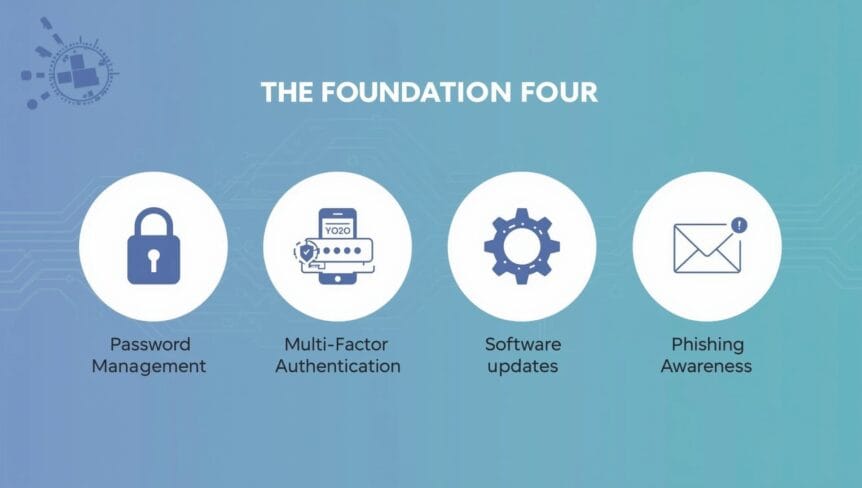Cybercriminals have dramatically shifted their targeting strategies in 2025, with small and medium businesses bearing a substantial share of attacks, roughly 43–50% depending on the study you look at. The myth that hackers only pursue large corporations has been thoroughly debunked as criminals increasingly recognize that smaller organizations often lack robust security infrastructure while still possessing valuable data.
The financial implications are sobering; while costs vary widely by incident and industry, 2025 analyses put typical small-business recovery costs in the low six-figure range (often around $120,000–$150,000), with some events far exceeding that. For context, IBM reports a global average cost per breach of about $4.4 million across organizations of all sizes. Beyond immediate financial losses, the reputational damage can linger for years, eroding client trust and complicating business relationships that took decades to build.
What’s surprising is how effective simple security practices can be against these sophisticated threats. Research from the National Cybersecurity Alliance shows that implementing just four fundamental security habits can prevent up to 85% of common cyber attacks. The protection power comes not from expensive systems or complex protocols, but from consistent application of straightforward practices that create significant barriers for potential attackers.
The Foundation Four: Core Security Practices That Actually Work
Security experts have identified four foundational practices that provide impressive protection against common threats. These core habits—strong password management, multi-factor authentication, regular software updates, and phishing awareness—form a powerful security framework accessible to everyone regardless of technical expertise.
What makes these practices particularly valuable is their effectiveness compared to their simplicity. Many organizations invest heavily in advanced security solutions while neglecting these basics, creating an illusion of protection while leaving fundamental vulnerabilities exposed. The Foundation Four address the most commonly exploited weaknesses without requiring significant time investment or workflow disruption.
Implementing these practices can be seamlessly integrated into your existing routines. The key is consistency and understanding the importance of each component. Let’s examine how each practice works and how you can incorporate them into your professional life.
1. Master Your Passwords (And Let Technology Help)
Password standards have evolved significantly, with 16+ characters now considered the minimum for adequate protection. This length requirement exists because modern cracking tools can brute-force shorter passwords in minutes or hours, while properly constructed 16-character passwords would take centuries to crack using current technology.
The most dangerous password habit among professionals isn’t using simple passwords; it’s reusing them across multiple accounts. Multiple 2024–2025 surveys find 44%–62% of employees reuse passwords or close variations, and some consumer studies report even higher rates depending on the population. This creates a situation where a breach of one service can compromise any accounts sharing those credentials, especially business accounts that may contain sensitive client information or financial data.
Password managers have transformed from optional tools to essential business utilities. These secure applications generate unique complex passwords for each account while requiring you to remember just one master password. The technology eliminates the cognitive burden of remembering dozens of credentials while dramatically improving your security posture.
For businesses transitioning to stronger password practices, start with your most critical accounts; email, financial services, and primary business systems. Create unique, lengthy passwords for these services first, then gradually expand to all professional accounts. Most password managers offer business plans that allow secure credential sharing among team members without exposing the actual passwords, solving common workflow challenges.
2. Add That Extra Security Layer with Multi-Factor Authentication
Multi-factor authentication (MFA) creates an additional verification step beyond passwords, effectively blocking 99.9% of automated account compromise attempts. This protection works because even if credentials are stolen, attackers cannot access accounts without the secondary verification method.
When implementing MFA, prioritize your most sensitive accounts first. Start with email accounts (which can be used for password resets), financial services, and core business applications. For most professionals, securing these three categories provides immediate protection for your most valuable digital assets.
Various MFA methods offer different balances of security and convenience. Authenticator apps provide excellent security without requiring cell service, making them ideal for business travelers. Hardware security keys offer the strongest protection but require physical possession. SMS verification, while better than no MFA, has vulnerabilities and should be considered a minimum rather than optimal solution.
One critical warning sign: legitimate organizations will never call, text, or email requesting your MFA codes. Any such request is invariably a scam attempt. These codes are meant only for direct entry on official websites or apps, and sharing them compromises the entire purpose of MFA protection.
3. Keep Your Digital Tools Sharp with Updates
Software updates represent far more than new features or interface changes; they primarily deliver security patches addressing vulnerabilities discovered since the previous version. These patches close known security gaps that hackers actively exploit to gain unauthorized access.
The common habit of postponing updates creates a dangerous security situation. Each delay extends the window during which your systems remain vulnerable to known exploits. Cybercriminals specifically target systems running outdated software versions, knowing these systems contain unpatched vulnerabilities.
Configuring automatic updates provides the most consistent protection with minimal effort. Most operating systems and applications allow scheduled updates during off-hours, preventing work interruptions while ensuring security patches are promptly applied. For business-critical systems where updates must be tested first, establish a regular schedule that minimizes the vulnerable period.
Remember that mobile devices require the same update discipline as traditional computers. Smartphones, tablets, and even smartwatches often contain sensitive business information and access credentials. These devices should be included in your regular update routine to maintain complete protection across your digital ecosystem.
4. Spot and Dodge Phishing Attempts Like a Pro
Phishing remains the predominant initial attack vector against businesses, with over 70% of breaches beginning with a deceptive email, message, or call. These attacks have become increasingly sophisticated, often mimicking legitimate communications from trusted organizations or colleagues.
Emotional manipulation lies at the core of successful phishing. Messages create artificial urgency (“Your account will be locked in 24 hours”), fear (“Unusual activity detected”), or excitement (“You’ve qualified for a special offer”) to bypass rational analysis and trigger immediate action. Recognizing these emotional triggers helps identify potential phishing attempts.
Implement the hover-before-you-click rule as standard practice. Before clicking any link, hover your cursor over it to reveal the actual destination URL. Legitimate organizations use domains that match their official websites, while phishing attempts often use similar-looking but slightly different domains. This simple verification step prevents many successful attacks.
When you encounter suspected phishing, proper reporting helps protect your entire organization. Forward suspicious emails to your IT security team or use built-in reporting features in email platforms. This reporting allows security teams to block similar attempts and alert colleagues who may have received the same message.
Beyond the Basics: Additional Security Practices for Complete Protection
While the Foundation Four provide substantial protection, additional practices create a more comprehensive security posture. These supplementary measures build upon the core practices without requiring significant technical expertise.
Backup Your Business Life with the 3-2-1 Rule
Data backups function as your insurance policy against both human error and malicious attacks like ransomware. The 3-2-1 backup strategy provides a practical framework for effective data protection: maintain three total copies of important data, store two backup copies on different storage types, and keep one copy offsite.
This approach ensures redundancy while protecting against different failure scenarios. If ransomware encrypts your primary systems, offline or cloud backups remain unaffected. If a local disaster damages physical infrastructure, offsite copies preserve business continuity.
For business professionals, cloud backup services offer compelling advantages including automatic synchronization, encryption, and accessibility from multiple locations. However, local backups provide faster restoration for large datasets. The optimal approach combines both methods to balance accessibility, speed, and protection.
The most overlooked aspect of backup strategy is verification testing. Regularly restore sample files or systems from your backups to confirm they function correctly. This testing prevents the devastating discovery that your backups are incomplete or corrupted when you need them most.
Secure Your Network Connections at Work and Home
For remote and hybrid workers, your home router represents your first security perimeter. Replace default administrator passwords immediately with strong alternatives, enable automatic firmware updates if available, and use WPA3 encryption when supported by your devices.
Public Wi-Fi networks present significant risks for business activities. These networks can be monitored or manipulated by attackers to intercept sensitive information. When working remotely, use mobile hotspots or VPN services to encrypt your connection, particularly when accessing financial accounts, client information, or proprietary business systems.
VPN (Virtual Private Network) services create an encrypted tunnel for your data, protecting it from interception even on compromised networks. While many businesses provide corporate VPNs, personal VPN services offer protection for independent professionals or when using personal devices.
Disable automatic connection features on your devices to prevent inadvertent connections to malicious networks. Smartphones and laptops often connect to previously used networks without verification, potentially exposing sensitive data. Configure your devices to request confirmation before connecting to wireless networks.
Smart Sharing: Protecting Your Professional Reputation Online
Professional social media profiles require regular privacy audits to maintain appropriate information boundaries. Review your settings quarterly to control who can view your posts, contact information, and connection lists. Particularly on business-oriented platforms, limit visibility of personal details that could be used in targeted attacks.
Cybercriminals mine professional profiles for information useful in crafting convincing phishing attempts. Details about your role, reporting structure, current projects, and business travel can be weaponized to create highly tailored messages that appear legitimate to you and your colleagues.
The oversharing challenge affects even security-conscious professionals. Seemingly harmless information like conference attendance, work schedules, or office locations provides valuable intelligence for social engineering attacks. Consider the potential security implications before posting work-related information publicly.
Carefully vet connection requests before accepting, particularly from unknown individuals. Fictitious profiles are commonly used to map organizational structures and relationships, gathering information for future attacks. Verify unknown contacts through alternate channels before accepting connection requests or responding to messages.
Making Security Habits Stick in Your Daily Routine
Transforming security best practices into habitual behaviors requires intentional integration into existing workflows. Rather than treating security as a separate activity, incorporate verification steps into regular processes. For example, add a quick link verification step before responding to emails or schedule password manager reviews during your weekly planning session.
Developing a security mindset means regularly considering how your actions might create vulnerabilities. Before sharing information, connecting devices, or granting permissions, pause briefly to evaluate potential risks. This momentary consideration often prevents significant security problems.
Create accountability by involving your team in security practices. Establish regular security discussions where team members can share concerns, ask questions, and reinforce positive habits. This collaborative approach normalizes security-conscious behavior while leveraging collective vigilance.
Recognize when professional assistance is appropriate versus handling security independently. While the practices outlined here provide substantial protection, complex security incidents or comprehensive security planning often benefit from specialized expertise. Partner with qualified IT security professionals for periodic security assessments and incident response planning.
Building Your Personal Security Action Plan
Begin your security improvement journey by addressing the Foundation Four practices first. Start with password management and MFA for critical accounts, as these provide immediate protection against the most common attack vectors. Set a specific implementation timeline with deadlines for each major account category.
Create a realistic security enhancement schedule that acknowledges your other responsibilities. Rather than attempting comprehensive changes immediately, implement improvements incrementally over several weeks. This approach increases compliance while reducing resistance to new security habits.
Track your progress using a simple security checklist covering each practice discussed. Note completion dates and schedule regular reviews to maintain momentum. This documentation also proves valuable during security audits or when demonstrating due diligence in protecting business and client information.
Stay informed about emerging threats and solutions through reputable security resources. The Cybersecurity and Infrastructure Security Agency (CISA), National Cybersecurity Alliance, and industry-specific security organizations provide regularly updated guidance for business professionals. Dedicating just 15 minutes weekly to security news helps maintain awareness without overwhelming your schedule.
By implementing these fundamental security practices, you create formidable protection against common threats while demonstrating professional responsibility in an increasingly interconnected business environment. Remember that digital security isn’t about achieving perfection; it’s about consistently applying proven practices that significantly reduce your vulnerability.





